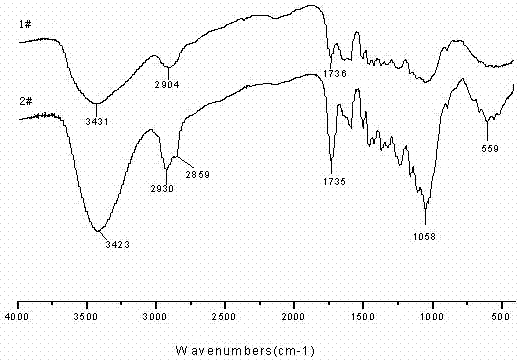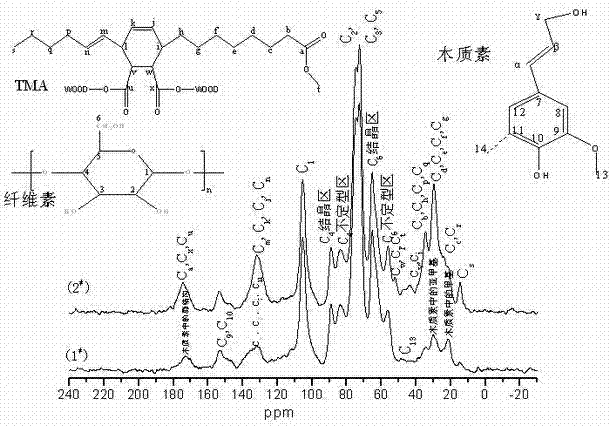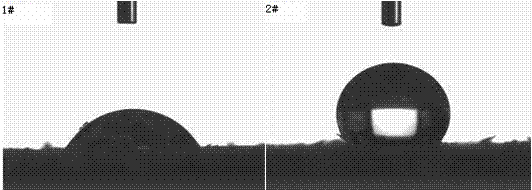Method for manufacturing methyl malei-eleostearate anhydride modified wood fiber
A technology of methyl tungalic anhydride and wood fiber, which is applied in fiber treatment, plant fiber, textiles and papermaking, etc., can solve the problems of few application reports, achieve abundant and cheap resources, enhance interface compatibility, and surface polarity Reduced effect
- Summary
- Abstract
- Description
- Claims
- Application Information
AI Technical Summary
Problems solved by technology
Method used
Image
Examples
preparation example Construction
[0027] The invention provides a method for preparing surface modified fibers. Methyl tungalic anhydride, a deep-processed product of natural vegetable oil tung oil, is used as a modifying agent to react with hydroxyl groups on the surface of wood fibers to produce methyl tungalic anhydride modified wood fibers. The surface polarity of the modified wood fiber manufactured by the method is reduced, and the surface hydrophobicity is improved, thereby enhancing the interfacial compatibility with the synthetic resin.
[0028] The used tungalic anhydride methyl ester is obtained by the addition reaction of tungalic acid methyl ester and maleic anhydride generated by the reaction of tung oil and excess methanol under the action of a catalyst. For the specific preparation method, refer to the tungalic acid methyl ester and di Elemental acid anhydride addition reaction method.
Embodiment 1
[0030] In a four-necked bottle equipped with a thermometer, a stirrer, and a condenser tube, add 2 parts by mass of wood fiber, 20 mL / (g poplar wood powder quality) dimethylformamide, 15 parts by mass of tungalic anhydride methyl ester respectively, at room temperature ( 25°C) after mixing, add 0.1 parts by mass of catalyst pyridine, and react at constant temperature for 6 hours; then the modified wood fiber is separated by suction filtration, and then extracted in Soxhlet with a mixed solvent (toluene:acetone:absolute ethanol volume ratio 4:1:1) Extracted in a device for 16 hours to remove unreacted small molecular compounds, and then dried in an oven at 105±2°C for 16 hours, and the weight gain of the obtained wood fiber was 3.6%.
Embodiment 2
[0032] In a four-necked bottle equipped with a thermometer, a stirrer, and a condenser tube, add 2 parts by mass of wood fiber, 20 mL / (g poplar wood powder mass) dimethylformamide, and 15 parts by mass of methyl tungalic anhydride, and mix at room temperature After heating to 60°C, add 0.1 parts by mass of pyridine as a catalyst, and continue the reaction at 60°C for 6 hours. Then cool down to room temperature, separate the modified wood fiber by suction filtration, and extract in a Soxhlet extractor for 16 hours with a mixed solvent (toluene:acetone:absolute ethanol volume ratio 4:1:1) to remove unreacted small molecule compounds , and then dried in an oven at 105±2°C for 16 hours, the weight gain percentage of the obtained wood fiber mass was 12.8%.
PUM
| Property | Measurement | Unit |
|---|---|---|
| particle size (mesh) | aaaaa | aaaaa |
Abstract
Description
Claims
Application Information
 Login to View More
Login to View More - R&D
- Intellectual Property
- Life Sciences
- Materials
- Tech Scout
- Unparalleled Data Quality
- Higher Quality Content
- 60% Fewer Hallucinations
Browse by: Latest US Patents, China's latest patents, Technical Efficacy Thesaurus, Application Domain, Technology Topic, Popular Technical Reports.
© 2025 PatSnap. All rights reserved.Legal|Privacy policy|Modern Slavery Act Transparency Statement|Sitemap|About US| Contact US: help@patsnap.com



